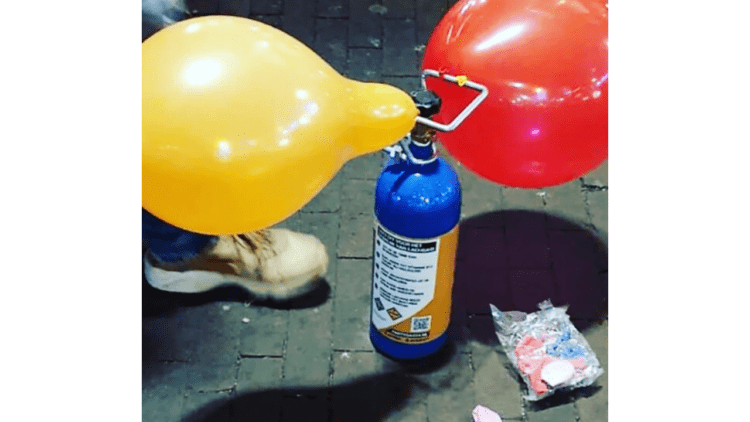Following the directive by the Chairman/Chief Executive of the National Drug Law Enforcement Agency (NDLEA), Brig. Gen. Mohamed Marwa (retd) to all commands and formations of the agency to begin an immediate clampdown on illegal sale and use of nitrous oxide, otherwise known as laughing gas, operatives have intercepted over 64,863.5 kilogram consignments of the gaseous substance at the Apapa seaport in Lagos and in Imo State.
Recall that the ban was as a result of its abuse by people who use it for recreational purposes.
NDLEA spokesperson, Femi Babafemi said following credible intelligence, NDLEA operatives at the Apapa seaport on Wednesday 12th July intercepted two containers marked MSKU 7626856 and MSKU 7689448 suspected to contain cartons of Nitrous oxide and plastic pressure release nozzles imported from China.
In the same vein, NDLEA operatives on patrol along Owerri – Onitsha expressway in Imo state on Thursday 13th July intercepted three cartons containing 18 canisters of the same substance weighing 11.5kg heading to Port Harcourt, Rivers State.
A swift follow up operation was conducted in the stadium road area of Elekahia, Port Harcourt same day leading to the arrest of the owner of the shipment, 24-year-old Tonye Kalio.
While commending the officers and men of the Apapa Port, and their Imo state command counterparts for being pro-active and swift, Marwa said the clampdown on illegal sale and use of nitrous oxide will continue nationwide to protect young Nigerians from the devastating effects of abusing the substance and in the overall interest of public health.
Introduction
Laughing gas, also known as nitrous oxide or N2O, has garnered attention in recent years due to its multiple applications, ranging from medical use to recreational purposes. This colorless, odorless gas has been utilized for its anesthetic and analgesic properties in the medical field, while it has also gained popularity as a recreational drug for its euphoric effects. However, the increasing prevalence of its misuse and the potential risks associated with its casual use have sparked debates on the need for education, regulation, and responsible practices.
Medical Applications and Benefits
Nitrous oxide has been used for more than a century as a safe and effective anesthetic agent. When properly administered by trained professionals, it can provide pain relief during dental procedures, childbirth, and minor surgeries. Laughing gas induces a state of mild sedation and euphoria, which helps alleviate anxiety and discomfort without the risk of respiratory depression, unlike other potent anesthetics.
Moreover, nitrous oxide’s short duration of action allows for a swift recovery from its effects, making it an attractive option for certain medical scenarios. In hospitals, it is often combined with oxygen to ensure a balanced mixture for controlled administration, reducing potential side effects.
Recreational Use and Potential Risks
The recreational use of laughing gas has seen a rise, particularly in social settings and party scenes. The gas is typically inhaled from balloons or whipped cream dispensers, leading to a quick onset of euphoria and giggling, hence the name “laughing gas.”
While some may consider it a relatively safe substance, especially when compared to other recreational drugs, the casual use of nitrous oxide carries potential risks. One of the primary concerns is oxygen deprivation. When inhaled excessively and without proper ventilation, nitrous oxide can displace oxygen in the lungs, leading to hypoxia (low oxygen levels in the body). This may result in dizziness, fainting, or, in severe cases, damage to vital organs and brain cells.
Furthermore, the improper use of nitrous oxide can lead to accidents or injuries, as users may become disoriented or lose motor control. Combining laughing gas with other substances or alcohol can exacerbate these risks, leading to dangerous outcomes.
Addressing the Issue: Education and Regulation
To tackle the issue of laughing gas misuse, a multi-faceted approach is required, involving education, regulation, and responsible practices.
Education: Promoting awareness about the risks and potential consequences of nitrous oxide misuse is crucial. This includes educating both medical professionals and the general public on proper administration techniques, indications, and contraindications for its use.
Regulation: Governments and healthcare authorities should implement and enforce regulations regarding the sale and distribution of nitrous oxide. Establishing clear guidelines for its medical use and discouraging its use in recreational settings can help minimize the potential for abuse.
Harm Reduction: Harm reduction strategies, such as providing safe environments for those who choose to use nitrous oxide recreationally, can mitigate some of the associated risks. This may involve offering access to proper equipment, promoting responsible consumption, and providing medical assistance if needed.
Conclusion
Laughing gas, with its dual identity as both a medical tool and a recreational substance, presents a complex issue that requires careful consideration. While its responsible medical use has long proven beneficial, its casual misuse can lead to significant health risks. To strike a balance, education, regulation, and harm reduction efforts must work in tandem to ensure that nitrous oxide remains a safe and effective option for those who need it, while minimizing its potential for abuse and harm in recreational settings.



